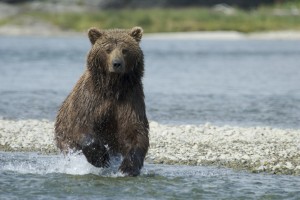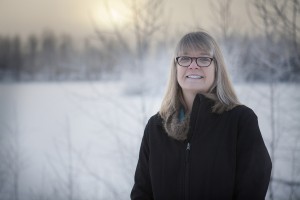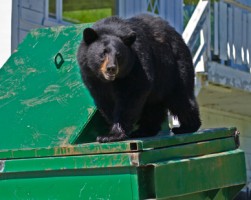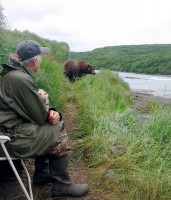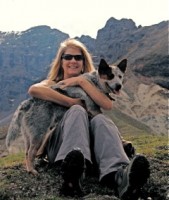This land is my land: 'frontier thinking' about bears
by Jamie Gonzales |
Every Alaskan has a bear story, whether it's a personal experience or borrowed from a friend. What does your story say about you? That you're connected to nature? Master of the outdoors? Brave? Clueless? Lucky?
If you're new to the state and lacking a story of your own, Sherry Simpson, a professor in UAA's graduate creative writing program and author of Dominion of Bears: Living with Wildlife in Alaska, offers to share some of her story collection with you in the final chapter of her new book. Although, if you're a linear reader, by the time you get to that invitation, you'll probably already have tucked a few stories in your back pocket to trot out at parties.
For example, the intermingling of bears and people began long, long ago. Simpson cites France's Chauvet Cave as proof of a 35,000-year-old relationship. On the walls are paintings of cave bears alongside bear claw marks, bones and footprints preserved in the soft floor.
How bears help define the Alaska self-image
Simpson references historian Morgan Sherwood in her first chapter to illustrate Alaska's complicated relationship with bears.
"It is difficult to envision what the popular image of Alaska might be, or how Alaskans would see themselves, or what would happen to their unique sense of place if there were no more bears in the state," wrote Sherwood in Big Game in Alaska (University of Alaska Press, 2008).
Beyond their place on the Alaska state quarter, bears are social currency for Alaska.
"Residency allows everyone to play two easy cards: one that says, Eh, it's no big deal living in bear country, and another that declares, No kidding, you could die almost anytime you step outside your front door," writes Simpson in her new book. "Without the threat of bears, what true dangers would a pioneer face, now that weather satellites, cell phones, snowblowers, central heating, and annual Permanent Fund dividend checks have eased the frontier's privations?"
Reporting from the fortress of the bears
Simpson began writing Dominion of Bears a few years ago, but her research, unwittingly, began years before in Juneau where she worked the outdoor beat as a journalist. One summer she had the opportunity to accompany biologists studying the effects of then-new Greens Creek Mine on the bears of Admiralty Island.
Known as "fortress of the bears," Admiralty Island, at 1,000 square miles, is home to an estimated one bear per square mile.
"So there we were flying around in a helicopter with late summer light in these peaks and the biologists were tagging and collaring bears. Of course, it's thrilling and exciting and scary and also you feel really empathic toward this animal that's just racing away," Simpson says.
She observed as the biologists drew blood, tattooed gums and affixed collars to the darted and anaesthetized animals. "And then one fellow told me to put my finger on the pulse of this bear," she says. "You feel this warm animal and touch her fur and see her close up. It changed everything I thought about bears after that. It was an animal I had dreamed about for years and was afraid of, but somehow once you see an actual bear that close, it changes your ideas."
That experience-changing her thinking about bears-became the start of a thread she followed throughout the book. It took her to state game sanctuaries and wilderness Alaska and deep into the state's digital and physical archives to trace the evolution of our co-existence with bears in Alaska and beyond.
Is it really possible for a state with visible frontier roots to shrug off Lewis-and-Clark thinking and creatively adapt to life with bears?
Simpson approached the question with more hope than she was able to sustain by the end of her research.
"I just don't see us having very much imagination to figure out how to deal with it differently," she says.
'Frontier thinking'
"There was one territorial governor who started a campaign to exterminate bears in Alaska," says Simpson.
"The bear is only a play thing of so-called sportsmen and should go the way of the buffalo because it impedes development," wrote Thomas Riggs, Jr. (as cited by an Alaska Department of Fish & Game (ADF&G) report). He was the second territorial governor of World War I-era Alaska.
One present-day manifestation of frontier thinking, says Simpson, is the idea that people belong here and animals-apex predators like bears or wolves-belong somewhere else. Another is that game animals like moose and caribou "belong" to people, an idea that puts us in competition with those other apex predators.
Every Alaskan has also seen evidence of or reference to "garbage bears." Every year, particularly during the summer fishing and grilling months, the Anchorage Daily News quotes Anchorage ADF&G biologist Jessie Coltrane, as they did her predecessor Rick Sinnott, in a story about bears getting into neighborhood trash cans. It's generally some variation on, "Boy, we sure wish residents were a little more mindful in how they discard trash."
"The biologists you call when there's a bear in your backyard, they're experts in human behavior, really," laughs Simpson. "Their big puzzle is figuring out how to get people to do what they need to do, not necessarily the bears."
What's in a name?
One way to change our thinking about living with bears is to pay careful attention to the way we speak about them, Simpson says. If they're referred to as ferocious beasts-many an Alaska kid, rather than tell ghost stories around the campfire, has scared herself stupid reading Alaska Bear Tales during a camping trip-they become something to be feared and best faced with the biggest gun you can lift. The term "garbage bears" triggers feelings of contempt.
Simpson's bear research introduced her to Pat Costello, a photographer in Juneau who was a driving force behind Juneau's push to clean up its act regarding bears in the city. He also taught her the power of rebranding.
"He said we should stop calling these bears 'garbage bears,' because that sounds like they're not worth anything," Simpson says. "They're 'urban bears.'"
Sharing the riverbank with Freddy Krueger
Simpson's research took her to storied bear-viewing areas in Brooks Camp, Chenik Lake, Geographic Bay and McNeil River State Game Sanctuary.
Visitors to McNeil are limited by a lottery system. Just 10 people at a time get to venture right into the heart of bear country, accompanied by a bear expert. Simpson was fortunate to visit during biologist Larry Aumiller's final season. He'd been living with and studying the McNeil bears for more than 30 years.
"One way [the McNeil staffers] tracked bears was to give them names and it wasn't to be cute," says Simpson.
Freddy (Krueger)-named for his scarred-up appearance and intimidating demeanor-was the dominant bear the year she visited. For four days, Simpson and her group sat and observed, no fences separated them from Freddy and the other bears. One of the best pictures in the book shows one of the Simpson's group members casually munching a sandwich a stone's throw from a brown bear.
What Aumiller and his colleagues learned through the years was that co-existing with the bears required humans to behave in very predictable ways. Notably, not a single bear has been killed in self-defense since the sanctuary was established in 1967.
It turns out, Simpson says, coastal bears are pretty tolerant of predictable humans. Key word: predictable. Scientists hypothesize that because these bears have to share close quarters with each other during prime fattening-up months, it readies them to accept humans in their territory more easily than the brown bears that live in interior regions.
Because Alaska really doesn't want to be California
Simpson's book plays with the idea of why we should care about bears.
"You can't claim that the world can't get along without bears because it can, obviously," she says. "It's just that it's a poorer and less interesting place because of it."
Heeding lessons from other U.S. state missteps might eventually influence the outcome of Alaska's identity animal. After all, many Alaskans shudder at the thought of being mistaken for residents of California, where the last remaining bear lives only on the state flag.
"They think there used to be 50,000 grizzlies in the Lower 48," says Simpson. "It did not take very long for them to go away."
For more essays about bears and people, check out Simpson's new book. When she's done archiving the bear files that have overrun her office, she'll be tackling the true crime story of a murder in Fairbanks, but still happy to field your inquiries about Dominion of Bears.
 "This land is my land: 'frontier thinking' about bears" is licensed under a Creative Commons Attribution-NonCommercial 4.0 International License.
"This land is my land: 'frontier thinking' about bears" is licensed under a Creative Commons Attribution-NonCommercial 4.0 International License.










